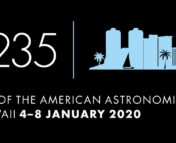In this series of posts, we sit down with a few of the keynote speakers of the 235th AAS meeting to learn more about them and their research. You can see a full schedule of their talks here, and read our other interviews here!
Good Things Come in Small Galaxies

When you think of observational cosmology, you might think of studying objects far away: measuring the polarization of the cosmic microwave background, or measuring the Hubble constant using extragalactic gravitational lenses. But Prof. Dan Weisz manages to do cosmological studies with objects much, much closer to home.
Weisz, an astronomy professor at the University of California Berkeley, uses nearby dwarf galaxies to do “near-field” cosmology. “We can learn a lot about the early universe from these very small systems,” he explains. “A lot of times we separate nearby galaxies and high-redshift galaxies as if they’re two very different areas. But in fact, galaxies that formed at high redshift had to evolve into something, and galaxies we see today had to be something at high redshift.”
Weisz’s group works to understand this fundamental connection by studying resolved stellar populations in nearby dwarf galaxies. This work has earned him the 2019 Newton Lacy Pierce Prize, awarded for “outstanding achievement, over the past five years, in observational astronomical research based on measurements of radiation from an astronomical object.” In his keynote #AAS235 talk on “The Life and Times of the Lowest Mass Galaxies,” Weisz will give a broad overview of major results in this subfield over the last few decades.
Reionization or bust
Weisz explains that reionization is one of the key topics in near-field cosmology. Within the last decade, theorists have predicted that “the universe couldn’t have been reionized at redshifts of 8-10 without very faint galaxies.” Unfortunately, says Weisz, “galaxies that were important for reionization are just too faint to be [directly] detected. So if we ever want to verify these predictions, it’s really going to rely on observations of local dwarf galaxies.”
To study these small systems, Weisz’s group primarily uses optical data from the Hubble Space Telescope and the Keck Observatory. Lately, he’s been working in two main research areas. “One is combining photometric and spectroscopic observations of resolved stars,” Weisz says. “The idea is that we have tons of data on resolved stars in dwarf galaxies, and we want to figure out how to maximally extract information about the ages or masses of stars, their chemical abundances, and their velocities–all at the same time!” These data can then be used “to piece together the full formation history of all of these galaxies.”

Weisz’s other main research avenue is the satellite galaxies of our nearest neighbor: M31, the Andromeda Galaxy (see figure). (Satellite galaxiesare the dwarf galaxies surrounding a larger galaxy.) He points out that “a lot has been invested in the Milky Way satellites, but we don’t really know if the Milky Way’s a typical galaxy, or if its satellites are typical.” Weisz was recently awarded a large amount of time (~250 orbits!) on the Hubble Space Telescope to measure the star formation histories and proper motions of 23 satellite galaxies of M31.
Some of his group’s preliminary work has suggested that the satellites of M31 have systematically different formation histories than Milky Way satellite galaxies—and this new data could be crucial in confirming this tantalizing result. If it holds up, this might suggest that our galaxy’s system of satellite galaxies is somehow unique, which would force us to re-examine our understanding of how dwarf galaxies form and evolve (and how they may have reionized the universe in the past).
In the future, Weisz hopes to use the James Webb Space Telescope to probe even farther. “JWST is going to let us […] measure star formation histories for dwarf galaxies outside the Local Group,” Weisz says, “so we can answer questions like ‘Is the Local Group typical?’”
“The intersection of happenstance and opportunity”
When asked how he got into dwarf galaxy research, Weisz shrugs. “A lot of things in our field are the intersection of happenstance and opportunity,” he says. “I went into grad school essentially knowing nothing about dwarf galaxies, other than that they sounded kinda interesting because they were so tiny.”
Weisz tried astronomy research for the first time as an undergrad, mostly focusing on supernovae. He didn’t start working on dwarf galaxies until his first year of graduate school—but his timing happened to be perfect: “At the same time, my advisor and some collaborators also got a bunch of time with the Hubble Space Telescope in the first few years I was in grad school. We went from having HST observations of a handful of dwarf galaxies to a hundred dwarf galaxies, and all of a sudden I had this thesis.”
What advice would Weisz give to students just starting research? “Stick with it,” he advises. “I think especially in the beginning as an undergrad, when you’re starting, it’s both exciting and overwhelming at the same time. […] It’s hard to see what the big picture is, or where you’re headed, and how you’re doing, and sometimes that can be discouraging. But I think it’s important if you really like what you’re doing, to stick with it and not be afraid to ask for feedback or advice.”
Weisz adds that finding good mentors is an important part of developing as a researcher: “The broad piece of advice I would add to that, and that I tell all the students I interact with, is that it’s important to pick a research mentor that you get along with—and that’s perhaps even more important than how interesting you find the science.”
If you find Prof. Weisz’s science interesting, check out his plenary talk at 3:40PM on Wednesday, January 8 at #AAS235!


